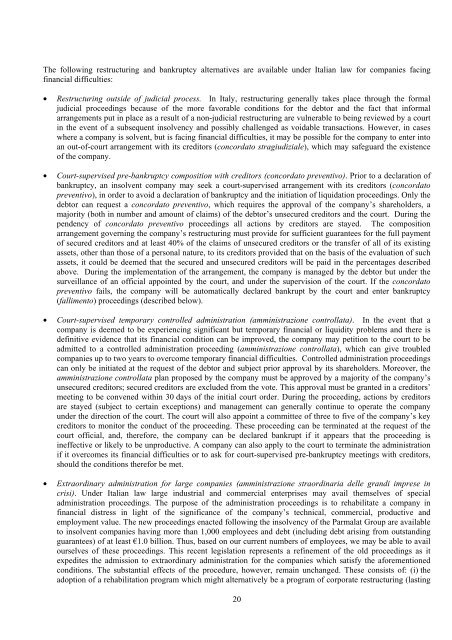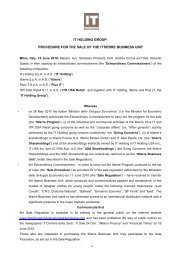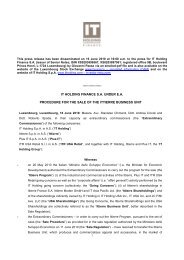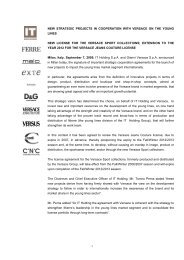You also want an ePaper? Increase the reach of your titles
YUMPU automatically turns print PDFs into web optimized ePapers that Google loves.
The following restructuring and bankruptcy alternatives are available under Italian law for companies facing<br />
financial difficulties:<br />
• Restructuring outside of judicial process. In Italy, restructuring generally takes place through the formal<br />
judicial proceedings because of the more favorable conditions for the debtor and the fact that informal<br />
arrangements put in place as a result of a non-judicial restructuring are vulnerable to being reviewed by a court<br />
in the event of a subsequent insolvency and possibly challenged as voidable transactions. However, in cases<br />
where a company is solvent, but is facing financial difficulties, it may be possible for the company to enter into<br />
an out-of-court arrangement with its creditors (concordato stragiudiziale), which may safeguard the existence<br />
of the company.<br />
• Court-supervised pre-bankruptcy composition with creditors (concordato preventivo). Prior to a declaration of<br />
bankruptcy, an insolvent company may seek a court-supervised arrangement with its creditors (concordato<br />
preventivo), in order to avoid a declaration of bankruptcy and the initiation of liquidation proceedings. Only the<br />
debtor can request a concordato preventivo, which requires the approval of the company’s shareholders, a<br />
majority (both in number and amount of claims) of the debtor’s unsecured creditors and the court. During the<br />
pendency of concordato preventivo proceedings all actions by creditors are stayed. The composition<br />
arrangement governing the company’s restructuring must provide for sufficient guarantees for the full payment<br />
of secured creditors and at least 40% of the claims of unsecured creditors or the transfer of all of its existing<br />
assets, other than those of a personal nature, to its creditors provided that on the basis of the evaluation of such<br />
assets, it could be deemed that the secured and unsecured creditors will be paid in the percentages described<br />
above. During the implementation of the arrangement, the company is managed by the debtor but under the<br />
surveillance of an official appointed by the court, and under the supervision of the court. If the concordato<br />
preventivo fails, the company will be automatically declared bankrupt by the court and enter bankruptcy<br />
(fallimento) proceedings (described below).<br />
• Court-supervised temporary controlled administration (amministrazione controllata). In the event that a<br />
company is deemed to be experiencing significant but temporary financial or liquidity problems and there is<br />
definitive evidence that its financial condition can be improved, the company may petition to the court to be<br />
admitted to a controlled administration proceeding (amministrazione controllata), which can give troubled<br />
companies up to two years to overcome temporary financial difficulties. Controlled administration proceedings<br />
can only be initiated at the request of the debtor and subject prior approval by its shareholders. Moreover, the<br />
amministrazione controllata plan proposed by the company must be approved by a majority of the company’s<br />
unsecured creditors; secured creditors are excluded from the vote. This approval must be granted in a creditors’<br />
meeting to be convened within 30 days of the initial court order. During the proceeding, actions by creditors<br />
are stayed (subject to certain exceptions) and management can generally continue to operate the company<br />
under the direction of the court. The court will also appoint a committee of three to five of the company’s key<br />
creditors to monitor the conduct of the proceeding. These proceeding can be terminated at the request of the<br />
court official, and, therefore, the company can be declared bankrupt if it appears that the proceeding is<br />
ineffective or likely to be unproductive. A company can also apply to the court to terminate the administration<br />
if it overcomes its financial difficulties or to ask for court-supervised pre-bankruptcy meetings with creditors,<br />
should the conditions therefor be met.<br />
• Extraordinary administration for large companies (amministrazione straordinaria delle grandi imprese in<br />
crisi). Under Italian law large industrial and commercial enterprises may avail themselves of special<br />
administration proceedings. The purpose of the administration proceedings is to rehabilitate a company in<br />
financial distress in light of the significance of the company’s technical, commercial, productive and<br />
employment value. The new proceedings enacted following the insolvency of the Parmalat Group are available<br />
to insolvent companies having more than 1,000 employees and debt (including debt arising from outstanding<br />
guarantees) of at least €1.0 billion. Thus, based on our current numbers of employees, we may be able to avail<br />
ourselves of these proceedings. This recent legislation represents a refinement of the old proceedings as it<br />
expedites the admission to extraordinary administration for the companies which satisfy the aforementioned<br />
conditions. The substantial effects of the procedure, however, remain unchanged. These consists of: (i) the<br />
adoption of a rehabilitation program which might alternatively be a program of corporate restructuring (lasting<br />
20






